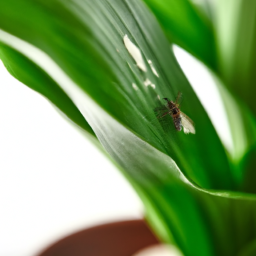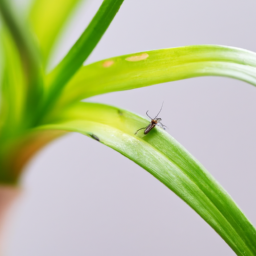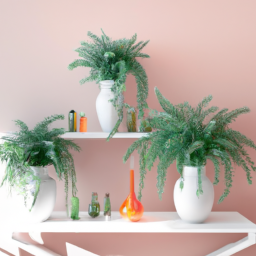
Have you ever noticed tiny flying insects buzzing around your indoor plants? If so, you may be dealing with a common nuisance known as gnats. Indoor plants and gnats often go hand in hand, as these pesky insects are attracted to the moist soil and organic matter found in potted plants. In this blog post, we will explore the relationship between indoor plants and gnats, as well as provide tips on how to effectively manage and prevent gnat infestations in your home. Let’s dive in and learn how to keep your plants healthy and gnat-free!
How to Get Rid of Gnats in Indoor Plants
Understanding the Problem
Gnats, also known as fungus gnats, are small flying insects that are commonly found around indoor plants. These pests are not only annoying but can also cause damage to your plants by feeding on the roots and laying eggs in the soil. If left untreated, a gnat infestation can quickly get out of control and harm your beloved indoor plants.
One of the main reasons why gnats are attracted to indoor plants is because of the moist environment that potted plants provide. The soil in indoor plants is often rich in organic matter, which serves as a breeding ground for gnats. Overwatering your plants can also contribute to the problem, as it creates the perfect conditions for gnats to thrive.
To effectively get rid of gnats in your indoor plants, it is important to understand the root cause of the infestation and take steps to address it. By following a few simple strategies, you can eliminate gnats from your plants and prevent them from coming back.
Identifying the Signs of a Gnat Infestation
Before you can effectively get rid of gnats in your indoor plants, you need to be able to identify the signs of a gnat infestation. One of the most obvious signs is the presence of small flying insects around your plants. These insects are typically black or gray in color and have long antennae.
Another sign of a gnat infestation is the presence of tiny white larvae in the soil of your plants. These larvae feed on the roots of your plants, causing damage and inhibiting their growth. If you notice any of these signs, it is important to take action immediately to prevent the infestation from spreading.
In addition to visual signs, you may also notice that your plants are not thriving as they should. Gnat infestations can cause stunted growth, yellowing leaves, and wilting. If you suspect that your plants are being affected by gnats, it is important to act quickly to save them from further damage.
Effective Strategies for Getting Rid of Gnats
There are several strategies that you can use to get rid of gnats in your indoor plants. One of the most effective methods is to let the soil dry out completely between waterings. Gnats thrive in moist environments, so allowing the soil to dry out will help to eliminate their breeding grounds.
You can also use yellow sticky traps to catch adult gnats and prevent them from laying eggs in the soil. These traps are easy to use and can be placed near your plants to attract and trap the flying insects. In addition to sticky traps, you can also use a mixture of water and dish soap to create a homemade gnat trap.
Another effective method for getting rid of gnats is to repot your plants in fresh, sterile soil. This will help to remove any eggs or larvae that may be present in the soil and prevent the infestation from spreading. Be sure to thoroughly clean the roots of your plants before repotting them to ensure that you are not transferring any pests to the new soil.
By following these strategies and taking proactive steps to prevent gnat infestations, you can keep your indoor plants healthy and pest-free. Remember to monitor your plants regularly for signs of gnats and take action immediately if you notice any issues. With a little bit of effort and diligence, you can effectively get rid of gnats in your indoor plants and enjoy a thriving indoor garden.

Best Indoor Plants for Gnats Prevention
Understanding Gnats and Their Attraction to Indoor Plants
Gnats are tiny flying insects that are commonly found in homes, especially around indoor plants. These pests are not only annoying but can also damage your plants if left unchecked. Gnats are attracted to indoor plants because they lay their eggs in the moist soil of the plant, where the larvae feed on organic matter and roots. This can lead to weakened plants and stunted growth. To prevent gnats from infesting your indoor plants, it is important to choose the right plants that are less attractive to these pests.
When selecting indoor plants, it is important to consider the soil type and moisture level that they require. Plants that require constantly moist soil are more likely to attract gnats, as they provide the perfect breeding ground for these pests. To prevent gnats from infesting your plants, choose plants that prefer drier soil and allow the soil to dry out between waterings. Additionally, avoid overwatering your plants, as this can create a humid environment that is ideal for gnat infestations.
Top Indoor Plants for Gnats Prevention
1. Snake Plant (Sansevieria trifasciata): Snake plants are known for their air-purifying properties and low maintenance requirements. These plants thrive in low light conditions and prefer dry soil, making them less attractive to gnats. Snake plants are also known to absorb toxins from the air, making them a great addition to any indoor space.
2. Spider Plant (Chlorophytum comosum): Spider plants are another great option for preventing gnat infestations. These plants are easy to care for and can thrive in a variety of light conditions. Spider plants prefer to dry out between waterings, making them less appealing to gnats. Additionally, spider plants are known for their ability to remove toxins from the air, making them a healthy choice for your indoor space.
3. Peace Lily (Spathiphyllum): Peace lilies are beautiful plants that can add a touch of elegance to any indoor space. These plants prefer to dry out between waterings and thrive in low light conditions. Peace lilies are also known for their air-purifying properties, making them a great choice for preventing gnat infestations. Additionally, peace lilies are non-toxic to pets, making them a safe option for homes with furry friends.
In conclusion, choosing the right indoor plants can help prevent gnat infestations and keep your plants healthy and thriving. By selecting plants that prefer drier soil and allowing the soil to dry out between waterings, you can create an environment that is less attractive to gnats. Consider adding snake plants, spider plants, or peace lilies to your indoor space to keep gnats at bay and enjoy the beauty of these plants in your home.

Common Signs of Gnats Infestation in Indoor Plants
Identifying the Problem
If you have indoor plants, you may have encountered the pesky problem of gnats at some point. These tiny insects can quickly infest your plants and become a nuisance in your home. But how do you know if you have a gnat infestation in your indoor plants? Here are some common signs to look out for:
First and foremost, you may notice adult gnats flying around your plants. These insects are small, usually black or gray in color, and have long legs and wings. They are often seen hovering around the soil of your plants or flying near the leaves.
Another sign of a gnat infestation is the presence of larvae in the soil. Gnat larvae are small, white worms that feed on organic matter in the soil. If you see these larvae crawling around in the soil of your plants, it is a clear indication that you have a gnat problem.
Additionally, you may notice that your plants are not thriving as they should. Gnats can damage the roots of your plants, causing them to wilt, yellow, or even die. If you see signs of poor plant health, it could be due to a gnat infestation.
Dealing with Gnats
Once you have identified a gnat infestation in your indoor plants, it is important to take action to get rid of these pests. Here are some steps you can take to deal with gnats in your plants:
1. Remove any decaying plant matter from the soil. Gnats are attracted to organic material, so by removing any dead leaves or debris from the soil, you can help eliminate their food source.
2. Allow the soil to dry out between waterings. Gnats thrive in moist environments, so by allowing the soil to dry out slightly between waterings, you can make the environment less hospitable for these pests.
3. Use yellow sticky traps to catch adult gnats. These traps are coated with a sticky substance that attracts gnats and traps them when they land on the surface. Place the traps near your plants to help reduce the gnat population.
4. Consider using a natural insecticide, such as neem oil, to control gnat populations. Neem oil is derived from the neem tree and is safe to use on indoor plants. It works by disrupting the life cycle of the gnats and can help reduce their numbers.
5. If the infestation is severe, you may need to repot your plants in fresh soil. This can help remove any remaining larvae or eggs in the soil and give your plants a fresh start.
Preventing Future Infestations
To prevent future gnat infestations in your indoor plants, there are some steps you can take to create an inhospitable environment for these pests:
1. Use a well-draining soil mix for your plants. Gnats thrive in moist soil, so by using a soil mix that drains well, you can help prevent them from laying their eggs in the soil.
2. Avoid overwatering your plants. Overwatering can create a damp environment that is ideal for gnats to breed. Make sure to water your plants only when the top inch of soil is dry to the touch.
3. Quarantine new plants before introducing them to your indoor plant collection. New plants can sometimes bring pests with them, so it is a good idea to keep them separate from your other plants for a few weeks to monitor for any signs of infestation.
By following these steps and being vigilant about monitoring your plants for signs of gnat infestations, you can keep your indoor plants healthy and pest-free. Remember, prevention is key when it comes to dealing with gnats in your indoor plants.
Let’s wrap up what we learned
If you’ve ever noticed tiny flying insects buzzing around your indoor plants, chances are you have a gnat problem. These pesky pests, also known as fungus gnats, thrive in moist soil and can quickly multiply if not addressed promptly. While they may not harm your plants directly, their larvae can feed on the roots, leading to stunted growth and potential damage.
To get rid of gnats in your indoor plants, there are a few simple steps you can take. First, allow the soil to dry out between waterings to disrupt the gnats’ breeding cycle. You can also try placing sticky traps near your plants to catch the adult gnats. If the infestation persists, consider repotting your plants with fresh, dry soil to eliminate any remaining larvae. By staying proactive and taking these measures, you can effectively control and prevent gnats from taking over your beloved indoor garden.
Here are this week’s Top Questions and Answers
Q1: Why do I have gnats in my indoor plants?
A1: Gnats are attracted to the moist soil of indoor plants, where they lay their eggs. Overwatering your plants can create the perfect environment for gnats to thrive.
Q2: How can I get rid of gnats in my indoor plants?
A2: To get rid of gnats, you can let the soil dry out between waterings, use sticky traps to catch adult gnats, or try a natural insecticide like neem oil.
Q3: Will gnats harm my indoor plants?
A3: While gnats themselves do not harm plants, their larvae can feed on plant roots, causing damage. It’s best to take action to get rid of gnats before they become a problem.
Q4: How can I prevent gnats from infesting my indoor plants?
A4: To prevent gnats, make sure not to overwater your plants, use well-draining soil, and regularly inspect your plants for signs of infestation.
Q5: Are there any indoor plants that are less likely to attract gnats?
A5: Some indoor plants, like succulents and cacti, require less water and are less likely to attract gnats. Consider adding these types of plants to your collection if you’re concerned about gnats.
Dr. Olivia Green is a botanist with over two decades of experience in indoor plant cultivation. She holds a Ph.D. in Plant Biology and has dedicated her career to researching plant behavior in controlled environments. Dr. Green is passionate about helping plant enthusiasts master the art of indoor gardening through her extensive knowledge and practical insights.


